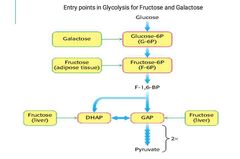![]()
![]()
![]()
Use LEFT and RIGHT arrow keys to navigate between flashcards;
Use UP and DOWN arrow keys to flip the card;
H to show hint;
A reads text to speech;
24 Cards in this Set
- Front
- Back
|
________ is generated by the oxidation of fuel molecules such as glucose, fatty acids, and amino acids. The common intermediate in most of these reactions is __________ |
ATP Acetyl CoA |
|
|
The carbon atoms of the acetyl unit are completely oxidized to CO2 by the citric acid cycle with the formation of NADH and FADH2. T/f |
True |
|
|
Jdj |
Jjjd |
|
|
ATP is generated via: _______________________ & ________________________ |
Substrate level phosphorylation: Production of ATP or GTP by the transfer of a phosphate group from a substrate directly to ADP or GDP. Oxidative phosphorylation: Synthesis of ATP via the transfer of electrons from NADH or FADH 2 to O2 by a series of electron carriers. |
|
|
_________ is the major electron donor in reductive biosynthesis. |
NADPH |
|
|
The central metabolic pathways have anabolic as well as catabolic roles. T/f |
True |
|
|
Glycolysis is sometimes called the ___________________, after Gustav Embden and Otto Meyerhof who made significant contributions to its elucidation in 1940. |
Embden Meyerhof pathway |
|
|
TYPES OF REACTIONS FOUND IN THE GLYCOLYTIC PATHWAY ARE: |
•Phosphoryl Transfer •Isomerization •Dehydration •Aldol Cleavage PIDA |
|
|
____________ is present in the small intestine, functions primarily as a fructose transporter. |
GLUT5 Mnemonics 5ructose |
|
|
_____________ has a Km value of 5 mM, transports glucose into muscle and fat cells. |
GLUT4 Mnemonics 4ought with all my strength and size |
|
|
__________ is present in liver and pancreatic β cells, is distinctive in having a very high km for glucose. (15- 20 mM) |
GLUT2
Note High kmM means they have low affinity for glucose |
|
|
_________&_________ are present in nearly all mammalian cells, are responsible for basal glucose uptake. Their K M value for glucose is about 1 mM, |
GLUT1&3 significantly less than the normal serum-glucose level, which ranges from 4 mM - 8 mM. Hence, they continually transport glucose into cells at an essentially constant rate. |
|
|
______________ is a rare genetic defect of glycolysis. |
Deficiency. Pyruvate Kinase Deficiency.Causes haemolytic anaemia. Glycolytic intermediates close to the pyruvate kinase step accumulate , whereas pyruvate and Lactate concentrations decrease. Causes haemolytic anaemia. Glycolytic intermediates close to the pyruvate kinase step accumulate , whereas pyruvate and Lactate concentrations decrease. |
|
|
____________ is the most frequent form of metabolic acidosis. It can occur as a result of overproduction of lactate, underutilization of Lactate or inhibition of pyruvate dehydrogenase. |
Lactic Acidosis. It may also be as a result of rare congenital disorders where the mitochondria does not function at full capacity or diabetic ketoacidosis as well as liver/kidney disease. It is characterized by Lactate levels> 5mM/L and serum pH<7.35 |
|
|
Ethanol is formed from _________ in yeast and several other microorganisms |
Pyruvate |
|
|
Pyruvate kinase from muscle and liver is allosterically inhibited by _______, so the conversion of PEP to pyruvate is blocked when the energy charge is high. |
ATP |
|
|
Hence, an abundance of fructose 6-phosphate leads to a higher concentration of F-2,6-BP, which in turn stimulates phosphofructokinase. Such a process is called ___________________. |
Feedforward stimulation |
|
|
_____________________is a potent activator of phosphofructokinase. ( PFK1) |
Fructose 2,6-bisphosphate (F-2,6-BP) |
|
|
Fructose 2,6-bisphosphate is formed in a reaction catalyzed by ___________________. |
PhosphoFructoKinase 2 (PFK2) |
|
|
The inhibition of phosphofructokinase leads to the inhibition of _______________ |
Hexokinase |
|
|
________________ is inhibited by its product, glucose 6-phosphate. High concentrations of glucose 6-phosphate is a signal that the cell no longer requires glucose for energy, but for storage in the form of glycogen, or as a source of biosynthetic precursors. |
Hexokinase. |
|
|
PFK is inhibited by : ______________ & ________________ |
(i) High levels of ATP: ATP binds to a highly specific regulatory site that is distinct from the catalytic site. The inhibitory action is reversed by AMP. (The activity of the enzyme increases when the ATP/ AMP ratio is lowered and vice versa.) (ii). High levels of Citrate: which indicates that biosynthetic precursors are abundant |
|
|
The glycolytic pathway has a dual role mention them: |
(i) Degrades glucose to generate ATP. (ii) Provides building blocks for synthesis of cellular components. The rate at which glucose is converted to pyruvate is regulated to meet these needs. |
|
|
What is the Entry points in Glycolysis for Fructose and Galactose |

Galatose : Glucose-6-phosphate. Fructose: Fructose-6-phosphate. |

